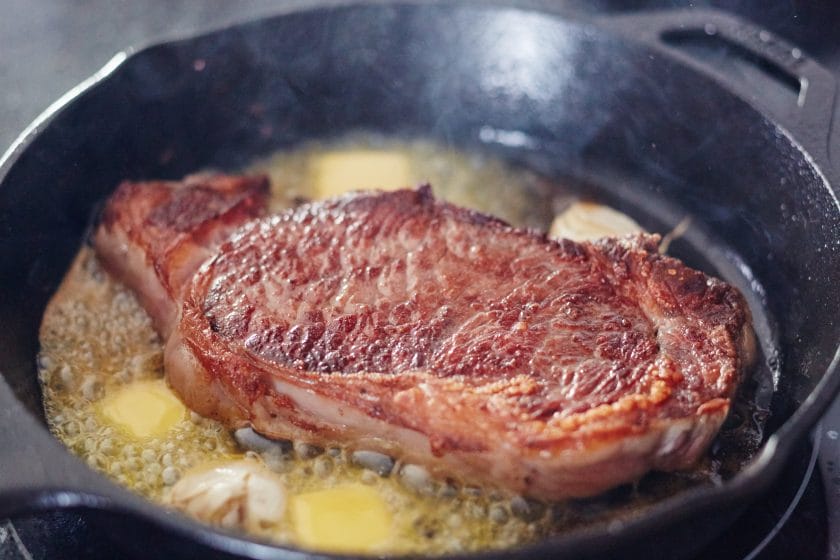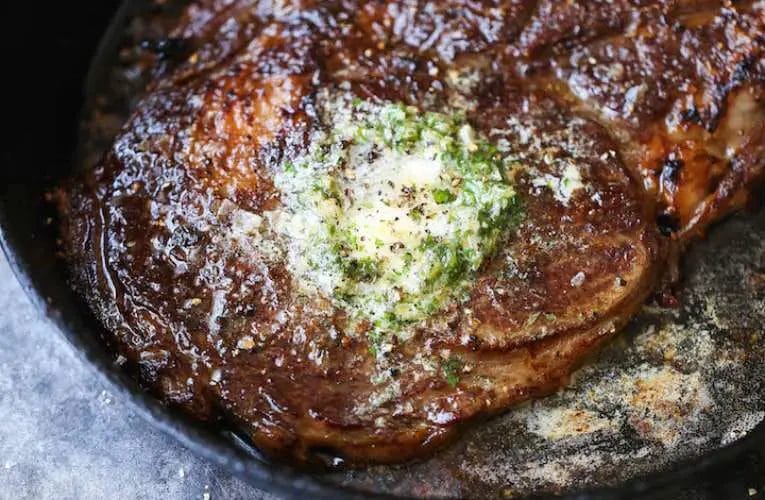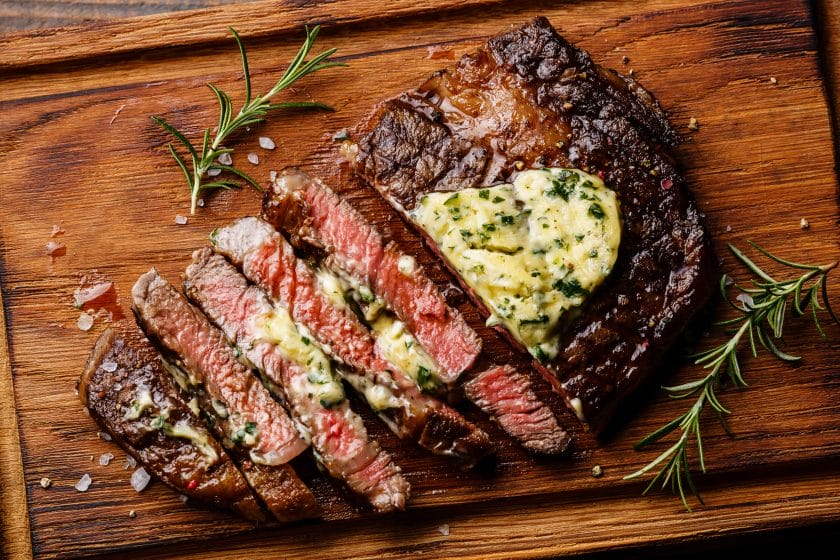If you’re wondering whether to cook steak with oil or butter, you’ve come to the right place. Both oil and butter can be used to cook a delicious steak, but they offer different flavors and cooking experiences.
When using oil, such as olive oil or vegetable oil, it provides a neutral base that allows the natural flavors of the steak to shine through. On the other hand, cooking steak with butter adds richness and a decadent taste to the meat. It also helps to create a beautiful caramelized crust on the steak.
Ultimately, the choice between oil and butter comes down to personal preference. If you’re looking for a lighter and more traditional approach, oil might be the way to go.
However, if you’re in the mood for a luxurious and indulgent steak, butter will certainly elevate your cooking. Experiment and find your favorite!

Best Cooking Methods for Steak
When it comes to cooking steak, there are several methods that can help you achieve that perfect, mouthwatering result. The cooking method you choose will depend on your preferences and the cut of steak you have.
Here, we will explore some of the best cooking methods for steak that will leave you with a tender, juicy, and flavorful piece of meat.
1. Grilling
Grilling is perhaps one of the most popular methods for cooking steak. It involves cooking the steak directly over an open flame or on a grill. This method is great for achieving a charred and smoky flavor.
To grill your steak, preheat your grill to high heat. Season your steak with salt, pepper, and any other desired seasonings. Place the steak on the hot grill and cook for a few minutes on each side, depending on the thickness of the steak and your preferred level of doneness.
For a rare steak, cook for about 4-5 minutes per side. For medium-rare, cook for about 5-6 minutes per side. And for medium, cook for about 6-7 minutes per side. Remember to let the steak rest for a few minutes before slicing and serving.
2. Pan-Searing
If you prefer a steak with a delicious crust and a tender interior, pan-searing is the way to go. This method involves searing the steak in a hot skillet and finishing it in the oven.
To pan-sear your steak, start by preheating your oven to 400°F (200°C). Season your steak with salt, pepper, and any other desired seasonings.
Heat a skillet over high heat and add some oil or butter. Once the skillet is hot, carefully place the steak in the skillet and sear it for about 2-3 minutes on each side.
After searing, transfer the skillet to the preheated oven and continue cooking the steak for about 6-8 minutes for medium-rare or until it reaches your desired level of doneness. Once done, remove the skillet from the oven and let the steak rest for a few minutes before slicing and serving.
3. Sous Vide
Sous vide cooking has gained popularity in recent years for its ability to consistently cook meat to the perfect temperature. This method involves vacuum-sealing the steak and cooking it in a water bath at a precise temperature.
To cook steak sous vide, season your steak with salt, pepper, and any other desired seasonings. Place the steak in a vacuum-sealed bag and remove any excess air. Fill a sous vide container with water and set the temperature according to your desired level of doneness.
Submerge the bagged steak in the water bath and cook it for the recommended time based on the thickness of the steak. Once the cooking time is up, remove the steak from the bag and pat it dry.
Sear the steak in a hot skillet for a minute on each side to develop a crispy crust. Let the steak rest for a few minutes before slicing and serving.
4. Broiling
Broiling is a cooking method that involves applying high heat from above to cook the steak. This method is quick and results in a flavorful and juicy steak.
To broil your steak, preheat your broiler and adjust the rack to the desired distance from the heat source. Season your steak with salt, pepper, and any other desired seasonings. Place the steak on a broiler pan or a wire rack set on top of a baking sheet.
Place the pan or baking sheet with the steak under the broiler and cook for a few minutes on each side, depending on the thickness of the steak and your preferred level of doneness.
For a rare steak, broil for about 4-5 minutes per side. For medium-rare, broil for about 5-6 minutes per side. And for medium, broil for about 6-7 minutes per side. Allow the steak to rest for a few minutes before slicing and serving.
5. Stir-Frying
If you’re looking to cook thin slices of steak quickly while retaining their tenderness, stir-frying is the ideal method. This method involves quickly cooking the thinly sliced steak in a hot pan or wok.
To stir-fry your steak, thinly slice the steak against the grain. Heat a pan or wok over high heat and add some oil. Once the pan or wok is hot, add the steak slices and stir-fry for a few minutes until they are cooked to

Using Oil vs. Butter for Cooking Steak
When it comes to cooking steak, using the right cooking fat can make a big difference in terms of flavor and texture. Two common choices for cooking fats are oil and butter. In this section, we will explore the pros and cons of using oil and butter for cooking steak and help you make an informed decision.
1. Oil for Cooking Steak
Using oil, such as vegetable oil or olive oil, has its advantages when it comes to cooking steak:
- High smoke point: Oil has a higher smoke point compared to butter, which means it can withstand higher cooking temperatures without burning. This is ideal for achieving a nice sear on the steak.
- Neutral flavor: Oil has a more neutral flavor compared to butter, allowing the natural flavors of the steak to shine through.
- Health considerations: Certain oils, like olive oil, have health benefits due to their monounsaturated fat content.
However, there are some potential downsides to using oil as well:
- Lack of richness: Oil does not provide the same level of richness and depth of flavor as butter.
- Potential for sticking: Some oils may have a higher tendency to stick to the pan, which can make flipping the steak more difficult.
2. Butter for Cooking Steak
Butter is a popular choice for cooking steak due to its rich flavor and ability to enhance the overall taste. Here are some reasons why you might consider using butter:
- Rich flavor: Butter adds a rich, creamy flavor to the steak, enhancing its taste.
- Browning capabilities: Butter has natural browning properties that can create a beautiful crust on the steak.
- Ease of use: Butter is easy to work with and spreads well on the steak.
- Improved tenderness: The fat content in butter can help keep the steak moist and tender.
However, there are a few drawbacks to using butter:
- Lower smoke point: Butter has a lower smoke point compared to oil, which means it is more likely to burn at high temperatures if not used correctly.
- Potential for overpowering flavor: The rich flavor of butter can sometimes overpower the natural taste of the steak.
- Saturated fat content: Butter is higher in saturated fat compared to many oils, which may be a consideration for those watching their fat intake.
Searing Steak: Oil or Butter?
When it comes to searing steak, one of the most debated topics is whether to use oil or butter. Both oils and butter have their own advantages and can contribute to the overall flavor and texture of the steak.
In this section, we will explore the pros and cons of using oil and butter for searing steak, allowing you to make an informed decision for your next steak-cooking adventure.
1. Oil
Using oil to sear steak is a popular choice among many chefs and home cooks. Here are some reasons why:
- Higher smoke point: Oils such as vegetable, canola, and avocado have higher smoke points compared to butter. This means that they can withstand higher temperatures without burning, allowing for a better sear on the steak.
- Neutral flavor: Oils have a neutral flavor, which allows the natural flavors of the steak to shine through. This is especially beneficial if you prefer the pure taste of the meat without any added flavors.
- Better heat distribution: Oils tend to distribute heat more evenly compared to butter. This ensures that the steak cooks evenly and prevents hot spots, resulting in a more consistent sear.
Despite these advantages, there are also a few considerations when using oil:
- Less flavor: While the neutral flavor of oil can be an advantage, some people prefer the rich and distinct taste of butter when searing steak. If you are looking for a buttery flavor, oil may not be the best choice.
- Drippings: When searing steak in oil, the drippings may not be as flavorful compared to using butter. This can affect the taste of any sauces or gravies that you may want to make with the drippings.
2. Butter
Using butter to sear steak is often favored by those who appreciate its rich and indulgent flavor. Let’s take a look at the benefits of using butter:
- Enhanced flavor: Butter adds a luxurious and savory taste to the steak, complementing its natural flavors. It can create a delicious caramelized crust on the outside of the meat.
- Moisture and tenderness: Butter has a higher fat content compared to oil, which can help to keep the steak moist and impart tenderness. This can be particularly beneficial for lean cuts of steak.
- Rich drippings: When searing steak in butter, the drippings are often more flavorful and can be used to create delicious sauces and gravies.
However, there are a few factors to consider when using butter:
- Lower smoke point: Butter has a lower smoke point compared to oils, meaning it can burn at higher temperatures. This can result in a less desirable flavor and potentially smoke up your kitchen.
- Uneven heat distribution: Butter has a tendency to brown quickly and can create hot spots on the cooking surface. This can lead to uneven cooking and searing of the steak.

Grilling Steak: Oil or Butter?
When it comes to grilling steak, one of the common debates among grilling enthusiasts is whether to use oil or butter. Both oil and butter have their own unique properties and can enhance the flavor and texture of the steak in different ways.
In this section, we will explore the benefits and drawbacks of using oil and butter for grilling steak.
1. Oil: Enhancing Flavor and Moisture
Using oil to grill steak has become a popular choice among many grill masters. The primary purpose of using oil is to prevent the steak from sticking to the grill grates.
Additionally, oil helps to enhance the flavor of the steak by locking in the natural juices and creating a delicious crust on the outside.
There are various types of oil that can be used for grilling steak, such as vegetable oil, canola oil, and olive oil. Vegetable and canola oil have high smoke points, making them suitable for high-temperature grilling. Olive oil, on the other hand, adds a rich and distinctive flavor to the steak.
When using oil, it is important to brush or rub it onto the steak evenly before grilling. This ensures that the steak is coated with a thin layer of oil, allowing it to cook evenly and develop a mouthwatering sear.
2. Butter: Adding Flavor and Tenderness
Butter is another option for grilling steak and offers a unique flavor profile. When melted, butter adds a rich and creamy taste to the steak, enhancing its overall flavor. Additionally, butter can help to tenderize the meat, resulting in a more juicy and succulent steak.
While butter can be a delicious choice for grilling steak, it is important to consider its lower smoke point compared to oil. This means that butter can burn easily at high temperatures, leading to a charred or bitter taste.
To overcome this, it is recommended to use clarified butter or ghee, which have a higher smoke point and can withstand the heat of the grill.
For grilling steak with butter, it is best to use a basting method. This involves periodically brushing melted butter onto the steak while it is cooking to infuse it with flavor and maintain its tenderness.
3. Choosing the Right Option
Ultimately, the decision to use oil or butter for grilling steak depends on personal preference and desired flavor profile.
If you prefer a simple and clean taste, oil may be the better choice as it allows the natural flavors of the steak to shine through. On the other hand, if you are looking to add richness and depth of flavor, butter can be a great option.
It is also worth mentioning that some grill masters like to use a combination of oil and butter. This allows them to benefit from the flavor-enhancing properties of both ingredients.
For example, they may choose to brush the steak with oil before grilling and finish it off with a pat of butter for added richness.

Pan-frying Steak: Oil or Butter?
When it comes to cooking a mouthwatering steak, the choice of cooking fat can greatly impact the flavor and texture of the meat.
Two popular options for pan-frying steak are oil and butter. Let’s explore the pros and cons of each to help you make an informed decision for your next steak cooking venture.
Oil
Using oil, such as vegetable or canola oil, is a common choice for pan-frying steak. Here are some reasons why you might consider using oil:
- Higher Smoke Point: Oils have a higher smoke point compared to butter, which means they can withstand higher temperatures without burning. This makes oil a great option for achieving a nice sear on the steak.
- Neutral Flavor: Oils generally have a neutral flavor, allowing the natural taste of the steak to shine through. This is particularly beneficial if you prefer to let the flavor of the meat take center stage.
- Health Considerations: Some oils, like olive oil, can have certain health benefits when consumed in moderation. They are lower in saturated fat compared to butter, making them a healthier option for those watching their fat intake.
However, it’s important to note that not all oils are created equal. Some oils, such as olive oil, have lower smoke points than others. If you choose to use oil, opt for a high smoke point oil to avoid the risk of burning and smoking up your kitchen.
Butter
While oil is a popular choice, many steak enthusiasts swear by using butter for pan-frying steak. Here are some reasons why butter might be your preferred cooking fat:
- Rich Flavor: Butter has a rich, creamy flavor that can enhance the taste of the steak. It adds a delicious nutty and slightly caramelized flavor to the meat.
- Basting: Butter is great for basting the steak during the cooking process. By spooning melted butter over the steak, you can infuse it with additional flavor and moisture.
- Tenderizing: The natural fats in butter can help tenderize the steak, resulting in a more tender and succulent final product.
However, butter does have some downsides when it comes to pan-frying steak. One major concern is its lower smoke point, which means it can easily burn at higher temperatures.
This can lead to a charred or bitter taste in your steak. To prevent this, it’s crucial to keep an eye on the heat and adjust accordingly when using butter.
Which Should You Choose?
Ultimately, the choice between oil and butter for pan-frying steak depends on your personal preference and cooking style. If you prioritize a high smoke point and a neutral flavor, then oil might be the better option for you.
On the other hand, if you desire a rich, flavorful steak with the benefits of basting and tenderizing, butter could be your go-to fat.
It’s worth noting that some chefs prefer to combine both oil and butter for the best of both worlds. They start by searing the steak in oil to achieve a crispy exterior and then finish it off with a butter baste for added flavor and moisture.
FAQs
1. Do you cook steak with oil or butter?
It is recommended to cook steak with oil rather than butter. Oil has a higher smoke point, which means it can withstand higher temperatures without burning.
This allows for a better sear on the steak. However, some chefs may choose to finish cooking the steak with butter to add flavor and richness.
Conclusion
In conclusion, when it comes to cooking steak, the choice between using oil or butter depends on personal preference and desired flavor. While oil is known for its high smoke point and ability to sear the steak quickly, butter adds richness and enhances the natural flavors of the meat.
Whether you opt for oil or butter, it’s important to use a high-quality option for the best results. Experimenting with different cooking methods and ingredients can help you discover your preferred way to cook steak to perfection.
So, fire up that grill or heat up the skillet and enjoy a deliciously cooked steak!


